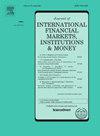Anticipated psychological spreads: Cryptocurrencies’ hidden short-term monitors and implications for price forecasting
IF 6.1
2区 经济学
Q1 BUSINESS, FINANCE
Journal of International Financial Markets Institutions & Money
Pub Date : 2025-09-17
DOI:10.1016/j.intfin.2025.102224
引用次数: 0
Abstract
Behavioral finance applications to cryptocurrency markets often neglect investor psychology surrounding support and resistance levels. This study introduces the anticipated psychological spread model (APSM), which formalizes chartist investors’ reactions to psychological price thresholds through loss aversion. Two behavioral indicators are defined: buyers’ anticipated psychological spread (BAPS), representing the perceived profit margin near resistance levels, and sellers’ anticipated psychological spread (SAPS), representing the anticipated profit margin near support levels. To examine the short-term price impact of these indicators, the study applies panel quantile regression to 32 cryptocurrencies from January 1, 2020, to January 31, 2024. An autoregressive integrated moving average with exogenous variables (ARIMAX)-based generalized autoregressive conditional heteroskedasticity (GARCH) framework is further employed to test robustness and evaluate the forecasting accuracy of the APSM. The results show that BAPS exerts a negative influence on prices, particularly during bear markets, while SAPS has a positive effect, especially in bull markets. Behavioral asymmetry analysis reveals buyer dominance over sellers throughout the study period. The APSM substantially improves short-term forecasting accuracy compared with classical ARIMAX–GARCH models. These findings indicate that BAPS and SAPS are valuable components for algorithmic trading strategies based on autoregressive models.
预期的心理价差:加密货币隐藏的短期监控和对价格预测的影响
行为金融学在加密货币市场的应用往往忽视了投资者围绕支撑位和阻力位的心理。本研究引入了预期心理价差模型(APSM),该模型通过损失厌恶来形式化图表投资者对心理价格阈值的反应。定义了两个行为指标:买方预期心理价差(BAPS),代表阻力位附近的感知利润率;卖方预期心理价差(SAPS),代表支撑位附近的预期利润率。为了检验这些指标的短期价格影响,该研究对2020年1月1日至2024年1月31日期间的32种加密货币进行了面板分位数回归。采用基于自回归外生变量积分移动平均(ARIMAX)的广义自回归条件异方差(GARCH)框架检验了APSM的稳健性和预测精度。结果表明,BAPS对价格具有负向影响,特别是在熊市中,而SAPS对价格具有正向影响,特别是在牛市中。行为不对称分析揭示了买方在整个研究期间对卖方的支配地位。与经典ARIMAX-GARCH模型相比,APSM显著提高了短期预报精度。这些发现表明,BAPS和SAPS是基于自回归模型的算法交易策略的有价值的组成部分。
本文章由计算机程序翻译,如有差异,请以英文原文为准。
求助全文
约1分钟内获得全文
求助全文
来源期刊
CiteScore
6.60
自引率
10.00%
发文量
142
期刊介绍:
International trade, financing and investments, and the related cash and credit transactions, have grown at an extremely rapid pace in recent years. The international monetary system has continued to evolve to accommodate the need for foreign-currency denominated transactions and in the process has provided opportunities for its ongoing observation and study. The purpose of the Journal of International Financial Markets, Institutions & Money is to publish rigorous, original articles dealing with the international aspects of financial markets, institutions and money. Theoretical/conceptual and empirical papers providing meaningful insights into the subject areas will be considered. The following topic areas, although not exhaustive, are representative of the coverage in this Journal. • International financial markets • International securities markets • Foreign exchange markets • Eurocurrency markets • International syndications • Term structures of Eurocurrency rates • Determination of exchange rates • Information, speculation and parity • Forward rates and swaps • International payment mechanisms • International commercial banking; • International investment banking • Central bank intervention • International monetary systems • Balance of payments.

 求助内容:
求助内容: 应助结果提醒方式:
应助结果提醒方式:


